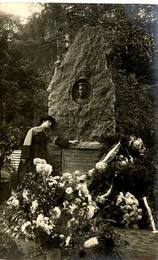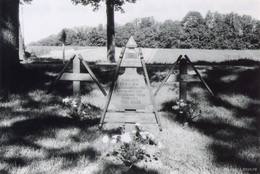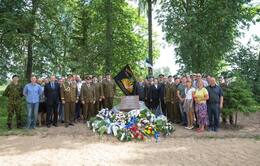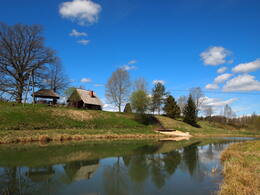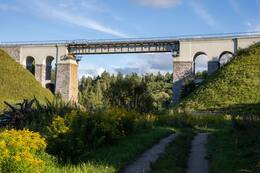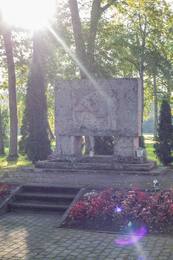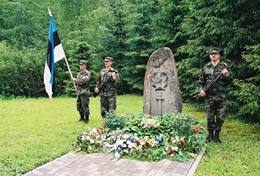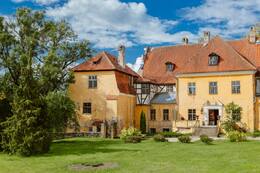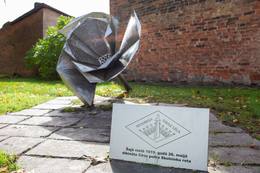The beginning, course and conclusion of the Battle of Cēsis
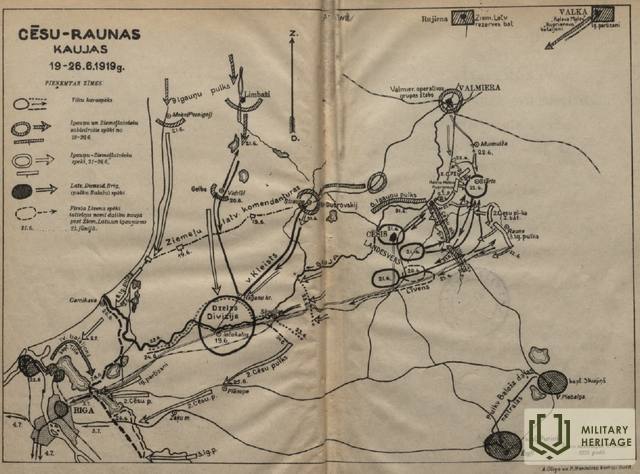
The victory in the Battle of Cēsis was destined to become a turning point in the Latvian and Estonian struggle for the independence of their country. This victory put an end to the plans of the Andrievs Niedra government and the German general Rüdiger von der Goltz to conquer the Baltics. Instead, the Latvian Provisional Government of Kārlis Ulmanis resumed its activities in Liepāja.
Events in Latvia before the Battle of Cēsis
After more than four years of World War I fighting and the Bolshevik coup in Russia, on November 18, 1918, a week after the armistice of World War I, the state of Latvia was proclaimed in Riga. Kārlis Ulmanis became the head of the Provisional Government. The territory of Latvia was devastated, and out of 2.5 million inhabitants, approximately one million were refugees in Russia.
Latvia and part of Estonia were occupied by the Germans, but Bolshevik troops stood on the eastern border, which, after the annulment of the Brest Peace Treaty of November 13, 1918, went on the offensive with the aim of conquering the former outlying provinces of Tsarist Russia - Latvia and Estonia. On December 17, the Bolsheviks entered Valka and proclaimed the Soviet Republic of Latvia, while the second group of troops went to Riga via Daugavpils. The German troops did not offer serious resistance to the Bolsheviks.
To save the situation, on December 7, the Provisional Government concluded an agreement with the German government on the formation of joint troops to fight the Bolsheviks. The agreement provided for the formation of 18 Latvian companies, 3 Latvian batteries, 7 German companies and 2 batteries, totaling 6,000 soldiers and 870 horses. The Germans fulfilled the agreement only partially, mainly forming their own units, but not providing the Latvians with weapons. Meanwhile, communist troops occupied Latgale and Vidzeme in less than a month and approached Riga.
The representative of the German government, A. Vinnig, contrary to his earlier promises and the desire of the Allies to delay the capture of the city, announced that German troops would not defend Riga. The Bolsheviks entered Riga on January 4, 1919. Two Latvian companies under the command of Lieutenant Colonel Oskars Kalpaks retreated towards Courland. The Provisional Government moved to Liepāja. At the end of January, the Bolshevik troops were stopped at Venta, approximately 100 km east of Liepāja. On February 1, 1919, German General Rüdiger von der Golz arrived in Liepāja from Germany. He was entrusted with commanding the Landeswehr (consisting of the Baltic German National Guard and the Iron Division formed from volunteer German citizens) and the Latvian Separate Battalion in the fight against the Bolsheviks.
Thanks to the efforts of the Provisional Government, the Separate Battalion eventually became a brigade. The offensive against the Bolsheviks launched on March 3, 1919 improved the situation at the front, and the communist-led troops were gradually forced to retreat towards Riga.
The situation in Estonia was much better: human losses in the world war were much lower, the influence of communist ideas was less, and the support of Finland allowed them to counterattack after initial failures and clear the territory of their country of the Red Army in January 1919.
Estonian troops had the opportunity to participate in the liberation of Northern Latvia from the Bolsheviks. On February 18, 1919, an agreement was signed between the Estonian government and the Latvian Provisional Government, which gave the Provisional Government's plenipotentiary for military affairs, Captain Jorģis Zemitāns, and the civil affairs representative, Engineer Markus Gailītis, the opportunity to organize Latvian troops in Estonia. The 1st Latvian Valmiera and 2nd Cēsis Infantry Regiments were formed in Tērbat (now Tartu). Thus, the foundations of the Northern Latvia Brigade were laid, which was operationally subordinated to the commander of the 2nd Division of the Estonian Army.
On April 16, at a time when the first successes in the fight against the Bolsheviks were being felt, the Germans staged a coup in Liepāja, overthrowing the legitimate Provisional Government, which had to seek refuge on the steamer “Saratov”. The Germans managed to form a puppet government led by the priest and writer Andrievs Niedra.
On May 22, 1919, German units liberated Riga from the Bolsheviks. A day later, Colonel Jānis Baložs' brigade entered the city, stopping the mass murders of civilians committed by the Germans.
The Bolshevik government and troops of Peter Stučka fled to Latgale, because in May the combined Estonian-Latvian forces had liberated the northern Latvian border region from the Bolsheviks and, starting from Ainaži, Rūjiena, Valka and Alūksne, were advancing towards Cēsis through Valmiera. On June 1 and 2, the Cēsis infantry regiment under the command of general Krišjānis Berķis entered Cēsis. It seemed that the Northern Latvian brigade, the Estonians, the Landeswehr, and the southern brigade of Jānis Baložs had one goal – to continue the fight against the Bolsheviks and drive them out of Latvia. However, the Landeswehr and the German Iron Division, instead of moving from Riga to the East and pursuing the Bolsheviks, turned north – towards the combined Estonian-Latvian forces in Vidzeme.
Battle of Cēsis
German General Rüdiger Count von der Golz planned not only to eliminate the independent states of Latvia and Estonia, but also to go to Petrograd to restore the Russian monarchy and later take revenge on the Entente powers for Germany's defeat in World War I.
German forces did not go in the direction of Rēzekne-Daugavpils, but on June 2 entered Ieriķi station (12 km from Cēsis) and demanded a free passage to Cēsis. The North Latvian Brigade, in communication with the commander-in-chief of the Estonian army, Johan Laidoner, refused to let the Germans into Cēsis. On June 3, two Landeswehr squadrons entered Cēsis. Thanks to the actions of the chief of staff of the North Latvian Brigade, Voldemars Ozols, the Germans were surrounded and left Cēsis without a fight. On June 5, between Cēsis and Ieriķi, the Germans attacked an Estonian armored train. The Battle of Cēsis began, which can be divided into two stages.
On June 6 at 3:00 in the morning, the Landeswehr launched a rapid attack, supported by strong artillery. The 7 km wide front had to be defended by three more or less trained companies of the 2nd Cēsis Infantry Regiment and three companies formed over the last two days, one of which was a schoolboy company – 16-18 year old boys, supported by two Estonian armored trains. After 10 hours of fighting, the Latvian troops could not withstand the triple German superiority and retreated to the right bank of the Rauna River, leaving Cēsis. On June 8, the Estonian units (6th and 9th regiments) that arrived launched a counterattack, which failed. On June 9, the Landeswehr launched an attack on the Rauna Bridge was also unsuccessful. On June 10, the Anglo-American Allied mission intervened in the conflict between the two sides. The fighting was stopped for 10 days. The second phase of the Cēsis battles began with an ultimatum from the Landeswehr commander, Major A. Fletcher, to the Commander-in-Chief of the Estonian Army, J. Laidoner, to withdraw Estonian troops to the ethnographic borders of Latvia. The Estonian High Command did not respond to this ultimatum, because, according to the Allied demands, the arrival of Landeswehr leaders for negotiations in Valka was scheduled for June 20.
The fighting began on the right bank of the Gauja at noon on June 19, when the forward units of the Iron Division clashed with the scouts of the Estonian 9th Regiment near Vidriži. On June 20, at 6:30 p.m., the commander of the Estonian 3rd Division, Ernests Peders, gave the order to begin hostilities against the Landeswehr.
However, on the night of June 20-21, the division headquarters received a report that the main German forces had launched an attack on the left bank of the Gauja, in the direction from Cēsis to Jaunrauna and Veselava, and desperate fighting was taking place near the Rauna Bridge, Lode Station, and Liepa Manor.
On the morning of June 21, the Landeswehr managed to break the front between the 2nd Cēsis Regiment and the 3rd Estonian Regiment. In the vicinity of Jaunrauna, the left wing of the 2nd Cēsis Regiment had to retreat. The course of the battle was significantly changed by the Kuperjanov partisan battalion commanded by Captain Unt. Having landed from the train, it launched a counterattack from Lode station in the direction of Liepa manor.
J. Kuprejanov's battalion, supported by an armored train and a Latvian artillery battery, withstood the battle with the Germans all day and in the evening took Liepa manor. Despite this Estonian partisan fight, the Landeswehr managed to bring a sufficient number of troops into the breach (approx. 6 km), which divided into three parts. One, in the direction from Jaunrauna, went to Lode station, where it clashed with the aforementioned J. Kuperjanov's battalion. The second part moved further to Skangaļi manor, but German scouts even went as far as Mūrmuiža (10 km from Valmiera); thus threatening the movement of armored trains from Valka to Cēsis. The third part, bypassing the right wing of the Estonian 3rd Regiment, went in the direction of Rauna. The Estonians stopped this German group on the Rauna highlands.
A dramatic situation developed in the Skangaļi manor area, where there were a lot of Landeswehr forces. The situation was saved by an echelon with fighters from the Kaleva Battalion and the 1st Regiment II Battalion, which arrived on June 22 at 3:00 in the morning. 3 km north of Lode station, the soldiers disembarked and, supported by the landing party of armored train No. 2, headed towards Skangaļi manor. At 6:30, these forces broke into the manor, but after a short while the Landeswehr recaptured Skangaļi manor. German losses – 60 killed. The number of Kalevaļi killed, wounded, and contused – 62. The Landeswehr began to retreat in disorder towards Cēsis. A few kilometers away, near Starti, the Germans lost another 31 killed. The other Estonian-Latvian units also launched active hostilities. The partisans of J. Kuperjanovs' battalion continued their attacks in the direction of Jaunrauna, cutting off the retreat of 3,000 Germans from Skangaļi. This ended on the decisive day of the historic battle. The enemy was defeated in the center.
Late in the evening of June 22, the plenipotentiary of the Republic of Estonia, N. Rēks, issued a directive:
"We must not give the enemy the opportunity to organize and regroup after the blow received in two days of fighting. We must continue to crush the enemy and take Cēsis."
Thus, June 23 was marked by the attack of the combined Estonian-Latvian forces on both banks of the Gauja.
At 7:30 a.m. Cēsis was taken, and at 8:00 a.m. the Estonian 6th Regiment on the right bank of the Gauja also launched a counterattack. In the evening of the same day, the enemy was thrown back 50 km from Cēsis to Inčukalns. On June 26, German forces were also driven from these positions to the outskirts of Riga. On July 3, the Armistice of Strazdumuiža was signed, forced by the Allies, which saved the Germans from complete disaster and gave them the opportunity to start fighting against the new Latvian state again in October under the Avalov-Bermont banner. Today, we can say with confidence that in the battles of Cēsis, Latvians fought for the independence of Estonia and Estonians for the independence of Latvia.
The role of the victorious countries of World War I – the USA, England, and France – in the creation of the free states of Latvia and Estonia
The right of self-determination of peoples declared by the Allies was intended to destroy the enemy – the German, Austro-Hungarian, Turkish empires and to create difficulties in the German-occupied territory of Eastern Europe, but was not intended to crush their own and the Russian empire. There was no unity among the Allies – England, France and the USA – also on the status of Latvia and Estonia. Only for a short time – until December 31, 1918, the British supported the independence of the Russian borderlands.
It was in the interests of the Americans and the French to restore the Russian Empire in order to preserve their invested capital. As a result of pressure from the Allies, the British government decided to stop active support for the provisional governments of the border states of Russia, using them only in anti-Soviet and anti-German combinations. We can justify this with the decision of the Entente of May 26, 1919, on the recognition of the autonomy of the Baltic peoples within the Russian Empire.
Only when the Germans in Latvia became unmanageable for the Allies (on May 23 and 24 in Liepāja, the Germans arrested Entente officers and instructors), after the Liepāja talks of June 5–7, did the Allies decide to use the Latvian-Estonian national armed forces to contain the Germans. This was also necessary because the German attack on the combined forces had interrupted the pursuit of the Bolsheviks, and this was not in the interests of the Entente. On June 22, the German National Council decided to sign a peace treaty with the Entente. Thus, the Estonians and Latvians, fighting in their own interests, had rendered a valuable service to the Entente, preventing a German attempt to seize absolute power in the Baltics. Only on June 25 did the Entente's top leadership decide that the Germans should no longer be supported. On June 28, the Germans signed the humiliating Versailles Peace Treaty for them.
Latvia 1919 - various governments during the War of Independence
The Latvian Socialist Soviet Republic government, led by Peter Stučka and supported by the Red Army, was located in the territory of Latvia. The goal of P. Stučka's government was to liberate the territory of the newly founded state and consolidate Soviet power there.
In Courland, there was a pro-German government led by Andriev Niedra, supported by the German Landeswehr and the Iron Division. The goal of this government was to drive the Bolsheviks out of Latvia, conquer as much territory as possible, and maintain German rule in the Baltics.
The third – the Latvian Provisional Government led by Kārlis Ulmanis had found refuge on the steamer “Saratov” after the German coup on April 16. The Southern Latvian Brigade commanded by Jānis Baložs in Courland and the Northern Latvian Brigade commanded by Colonel Jorģis Zemitāns in northern Latvia remained loyal to the K. Ulmanis government. Politically, both brigades were loyal to the Latvian Provisional Government, but militarily, the Southern Latvian Brigade was subordinate to General von der Golz, who also commanded the Landeswehr and the Iron Division, while the Northern Latvian Brigade was subordinate to the Commander-in-Chief of the Estonian Army, General Johan Laidoner.
Tālis Pumpuriņš, Cēsis History and Art Museum
Edgar Anderson's historical materials
Related timeline
Related topics
Related objects
Victory monument in Cēsis
The Victory Monument to Latvians and Estonians killed in the Battles of Cēsis is located in the city of Cēsis, on Vienības Square. In honour of the participants of the 1919 Battles of Cēsis, on 22 June 1924, the first stone was laid for the Victory Monument as sketched by architect Pauls Kundziņš, using funds donated by the people. During the Soviet occupation regime, on the night of 25 March 1951, the monument was blown up and taken down completely. A monument to Lenin, created by sculptor Kārlis Jansons, stood on the former Victory (Unity) Square from 1959 to 1990. In 1997, Māris Niklass, chairperson of the Cēsis District Council, managed to involve Estonian state institutions in the restoration of the monument. The material needed for the construction of the monument, Saaremaa dolomite, was received from Estonia as a gift. On 22 June 1998, during the celebrations of the 79th anniversary of the Battles of Cēsis, the first stone of the monument to be restored was laid on Vienības Square. A ceremony to unveil the restored Victory Monument took place in Cēsis on 15 November 1998 (author: architect Imants Timermanis). Information about the Victory Monument is available in the ‘Cēsis and the Latvian War of Independence’ exhibit of the Cēsis History and Art Museum, in the New Castle.
Monument commemorating the Cēsis battles
The monument to the Estonian and Latvian soldiers who died in the Battles of Cēsis is located in Priekuļi municipality, Liepā, about 1 kilometre south of the Lode Railway Station, on the side of Rūpnīcas street. The first stone of the monument was laid on 22 September 1929, and the monument was unveiled on 11 August 1935. Based on a sketch by Sculptor Augusts Julla who lived in Jullas, Liepa parish, and made of limestone from the village of Allaži, the monument is a high-relief depiction of a peasant soldier leaning on a plough with one hand and a raised sword in the other. The death mask of the sculptor’s father Jānis Julla was used to create the face of the sculpture. According to Aivars Vilnis, a researcher of the history of Liepa parish, a bird’s eye view of the monument reveals that the base of and the path and stairs leading to the monument form the shape of an arrow facing Liepa Manor (Lindenhoff) in the direction of German positions during the Battles of Cēsis. There is doubt, of course, as to whether this was truly the author’s intention at the time; however, it certainly enriches our interpretation of the monument today. Next to the monument are the only natural sandstone arches in Latvia known as ‘Lielā Ellīte’ (‘Liepas Ellīte’ or the Devil’s Kiln).
Cēsis history and art museum in the New Castle of Cēsis
The Cēsis History and Art Museum is located in the very centre of the Old Town of Cēsis, in the New Castle. The museum holds a permanent exhibit of history and interiors named ‘Cēsis, a Symbol of Latvian History’, with two thematic sections: the exhibit ‘Red-White-Red Flag in the History of Cēsis and Latvia’ explains the history of the Latvian national flag from the 13th to 20th centuries, the approved national symbol, the flags of Latvian rifle battalions and the traditions of using national colours during the Latvian War of Independence. The exhibit ‘Cēsis and the Latvian War of Independence’ focuses on the founding of the Cēsis Company in December 1918, the joint battle efforts of Estonians and Latvians in the 1919 Battles of Cēsis, the time when, during the Bermondt Affair, Cēsis served as the temporary capital of Latvia for a short time, as well as the history of the Cēsis Victory Monument. In an escape room named ‘Legends of the Battles of Cēsis’, the participants have one hour to find their way out by solving puzzles, making connections and finding hidden objects. The Cēsis Company, one of the first units of the Latvian Armed Forces, was established on 8 December 1918 in Cēsis Castle by Senior Lieutenant Artūrs Jansons. The museum’s exhibit features a memorial plaque dedicated to the Cēsis Company, unveiled on 8 December 1933 at the Cēsis New Castle, which, at the time, served as the headquarters of the 8th Daugavpils Infantry Regiment and the garrison officers’ club.
Monument for students of the Cēsis Regiment
The monument to the soldiers of the Cēsis Regiment Students’ Company who died in the Battles of Cēsis is located in the city of Cēsis, near the intersection of Palasta and Bērzaines streets. The construction of the monument was proposed by the Soldiers’ Association of the Cēsis Regiment Students’ Company. The monument was unveiled on 26 May 1938. The monument is based on the idea sketched by artist Jānis Rozenbergs, a former soldier of the company. Placed on a metre-high limestone pedestal, the 1.8-metre copper sculpture of a soldier dressed in a school student’s uniform was created by sculptor Rūdolfs Āboltiņš and coppersmith Jānis Zibens. An owl, a symbol of wisdom and knowledge, lies at the soldier’s feet, squatting on and protecting the books of a student who went to war. The sculpture was demolished during the Soviet re-occupation in 1952. A monument named the Komsomol Flag Bearer by sculptor Kārlis Jansons was erected near its former location in 1957. Placed near its historic site, the restored monument was unveiled on 11 November 1992. At the same time, in 1992, a monument to the Komsomol, which had been erected by the occupation regime, was taken down.
Monument at the site of the Battle of the Schoolchildren's Company
On the side of the Cēsis-Āraiši highway, near the former Livu parish house.
A monument dedicated to the volunteer student company of the Cēsis Regiment, which participated in the Battle of Cēsis in 1919, can be seen.
The monument was unveiled on May 29, 1930, near the former Livu parish house.
The monument project was developed by former student volunteer K. Dzirkalis, and the installation work was carried out by A. Sproģis' company in Cēsis.
The bronze details were made by M. Pluka according to the author's drawing, and they were cast at the V. Minūtas factory in Riga. After World War II, the monument was destroyed.
Restored on June 6, 1989, the authors of the restored monument were sculptors A. Jansons and M. Baltiņa, and architect I. Timermanis.
Later, the bronze sword and plaque were removed for safety reasons, replaced with wooden parts.
Memorial stone to the Latvian and Estonian soldiers who fell in the Battle of Cēsis near Rauna
Located in Priekuļi parish, on the side of the Cēsis–Valmiera highway, near the bridge over the Rauna River.
A memorial stone with a granite memorial sign made by stonemason Voldemārs Koltovs to the soldiers who fell in the Battle of Cēsis can be viewed.
Opened in 2004, when the 85th anniversary of the Battle of Cēsis was celebrated.
A memorial stone to the 110 Estonian and 44 Latvian soldiers who fell in battle on the banks of the Rauna and Gauja rivers.
In the battles near Rauna and Gauja, the 6th Regiment of the 3rd Estonian Division (commander K.Tallo), the 3rd Regiment (commander J.Krūss) and the 2nd Cēsis Regiment of the North Latvian Brigade (commander K.Berķis) fought heroically.
The first monument in memory of the Battle of Cēsis and the fallen Estonian soldiers
Located next to the Veselava cemetery chapel.
The first monument to commemorate the Battle of Cēsis and the fallen Estonian soldiers was unveiled on August 5, 1923.
Its opening was attended by the first President of the Republic of Latvia, Jānis Čakste, and the Estonian Ambassador to Latvia, Jūlijs Saljemā.
The cemetery contains the remains of 16 Estonian soldiers who fell in the battles of Cēsis with the Baltic Landeswehr and the Iron Division in June 1919. Four of them were later reburied in their homeland. The monument was built with donations collected from local residents. It was designed by craftsman Dāvis Gruzde, after the owner of the Ķikuri house, Kārlis Bierņš.
Cēsis Brothers' Cemetery
Located in the Cēsis Lower Cemetery, Lenču Street 15, Cēsis.
One of the most significant memorial sites of the First World War and the War of Independence in Cēsis is the Brothers' Cemetery in Lejas Kapis.
The cemetery houses the Brothers' Cemetery Monument, designed by Cēsis artist and councilor Augusts Julla (1872-1958), unveiled in 1927, and dedicated to the soldiers buried in the Brothers' Cemetery from 1915 to 1920.
About 200 soldiers are buried in the Brothers' Graves of the Cēsis Leja Cemetery. Among them are an unknown number of Latvian riflemen and Russian soldiers who fell in World War I, as well as soldiers of German (10), Polish and other nationalities. During the Latvian Liberation Struggles, 22 soldiers of the 5th (2nd) Cēsis Infantry Regiment were buried in this cemetery, as well as 11 freedom fighters who fell in other Latvian army units. 2 Estonians, 15 victims of the Bolsheviks, and Latvian Red Riflemen also rest in the Brothers' Graves.
Monument for students of the Viljandi Regiment
The monument to the soldiers of the Viljandi Students’ Company who fell near Stalbe is located by the intersection of the Riga-Limbaži road, after making a turn onto the Stalbe-Stūrīši road, which leads to the Pārgauja Municipal Council (to the right). Latvian and Estonian inscriptions on the granite memorial read: ‘On 19-21 June 1919, during the Battles of Stalbe, the 6th Regiment Viljandi Students’ Company repelled the attack of the Germans’. The monument was unveiled on 19 June 2009. Based on the idea conceived by Mareks Niklass, the monument was created by stonemason Voldemārs Koltovs. The 6th Estonian Regiment fought the Baltic Landeswehr and the Iron Division during the Battles of Cēsis near Stalbe. The Germans tried to break the front line in the area of the Stalbe Manor but were forced to retreat after two days of failed attempts. Every year, Lāčplēsis Day celebrations in Stalbe begin with a torchlight procession to the monument devoted to the soldiers of the Viljandi Students’ Company.
Monument in memory of the fallen soldiers of the Latvian Liberation War
The monument is located next to Limbaži Sv. St. John's Lutheran Church, Lībiešu Street 2. There is a memorial to the fallen soldiers of Limbaži and the surrounding area and to Lieutenant General Vilis Gelbe (1890-1919), who fell in the battle against the Germans on June 19, 1919 in Vidriži.
The monument of Lieutenant General Viļis Gelbe can be seen in the Limbaži cemetery in Jūras Street.
Monument to Naval Lieutenant, L.k.o.k. Vilis Gelbes (1890-1919)
Located at the Limbaži Jūras Street Cemetery, Jūras Street 56, Limbaži
On display is a monument unveiled on September 10, 1922 by the then President of Latvia, Jānis Čakste, which contains the dedication of the poet Vilis Plūdonis to Vilis Gelb:
"My people, who pass by me, burn with love for your fatherland,
"For the sake of my beloved fatherland, I pledge my life."
Vilis Gelbe (1890-1919) was born in Courland, in Zemīte parish, but was also closely connected to the Limbaži side, because when the Latvian War of Independence began, he returned to Latvia from St. Petersburg and joined the North Latvian Brigade.
In May 1919, V. Gelbi commanded in Limbaži, he became the military commandant of the area and was able to inspire the local men and even very young boys to join the army.
V. Gelbe's activities in Limbaži and its surroundings at that time were very significant; his duties included not only maintaining order in the city and its surroundings, but also mobilization, providing food for soldiers and horses, and resolving many other issues that could not be included in orders and instructions. The commandant's team organized by him acted as a coordinated mechanism to provide the North Latvian Brigade with the most effective assistance possible. The commandant's team went to the aid of the regular army in special cases, and he set an example for the new soldiers. V. Gelbe was the first officer of the Latvian army who proposed awarding his subordinates with the Order of Imanta, Class III. The order did not yet exist. The name of Imanta appeared in public only on March 20, 1920, when a presentation on the establishment of a military order was submitted to the Minister of Security, Kārlis Ulmanis. However, the name of Lāčplēsis was chosen for the order.
During the Battle of Cēsis, Vilis Gelbe died - on June 19, 1919, during a reconnaissance mission. Gelbe was later awarded the Lāčplēsis War Order, but historians believe that his contribution has not been properly appreciated. This is mainly due to Gelbe's membership in the North Latvian Brigade.
The so-called Southern Latvian Brigade, initially commanded by Oskars Kaplaks and later by Jānis Baložs, competed with the Northern Latvian Brigade, commanded by Jorģis Zemitāns.
A memorial in Vidriži at the place where LKOK Vilis Gelbe and two soldiers from his team fell.
In Vidriži, at the turnoff to Lēdurga, during the War of Independence on June 19, 1919, naval lieutenant Vilis Gelbe and two soldiers fell in battle.
Vilis Gelbe was buried in the Limbaži cemetery. For his heroic deed near the Vidriži manor, Vilis Gelbe was awarded the Lāčplēsis War Order, 3rd class (No. 895).
Currently, three Pemin crosses, installed in 1989, can be seen at the battle site.
On June 22, 1934, a bronze memorial plaque modeled after the artist Stefans Bercs was unveiled near the maple tree growing in the manor park. Already at the beginning of the communist occupation in the autumn of 1940, the memorial plaque disappeared. The maple tree to which it was nailed also perished. When the Awakening began, on June 19, 1989, on the 70th anniversary of the death of Gelbe and two soldiers from his team – Corporal Krustiņš and Private Krūze – at the crossroads where the memorial plaque once stood, at the initiative of the Environmental Protection Club and the Limbaži district branches of the Latvian Popular Front, three wooden crosses made in the folk style by Jānis Eglītis were installed. By decision of the Limbaži district executive committee in April 1991, this memorial site was included in the list of historical monuments of local importance.
Memorial at Skangaļi Manor
The memorial to the victory of the combined Latvian and Estonian troops in the battle for the Skangaļi Manor is located about 20 kilometres from Cēsis. Devoted to the participants of the Battles of Cēsis and the fighters of the Estonian Kalevlaste Maleva Battalion, the memorial stone was unveiled on 22 June 2019. The victory of the combined Latvian and Estonian troops in the battle for the Skangaļi Manor, which took place here, was a turning point in the Battles of Cēsis, as a result of which the troops of Niedra’s government initiated a general retreat. The government of Andrievs Niedra was a provisional pro-German government of Latvia, which existed from 10 May to 26 June 1919. The attack on the Landeswehr unit began in the early morning of 22 June 1919 when the 3rd Kalev company used an armoured train to break into the Skangaļi Manor where they seized 2 cannons, however, the enemy still went on a counterattack. The troops repeated the attack slightly later, in the middle of the day, and the Landeswehr unit was forced out of the Skangaļi Manor following fierce close combat. The trophies from the battle include machine guns, large quantities of ammunition and other combat equipment. Two hours later, the Estonians captured an important road junction at the Starti pub. 58 Kalev soldiers were injured or lost their lives in the battle to capture the Skangaļi Manor. Estonia provided significant support in establishing the memorial site.
Recreation Place “Meža kaujas”, the Main Venues of the Cēsis Battles near the Amata Bridge
Named Forest Battles, the rest area is situated in the main location of the Battles of Cēsis near the Amata bridge. Visitors can listen to stories about the Battles of Cēsis and can take part in various activities, including hikes and trips around the most important venues of the Battles of Cēsis, and team battles. At the end, the visitors can enjoy an invigorating wartime soup. The railway bridge over Amata played a very important role throughout the War of Independence, as the first clashes of the Estonian Army with the Landeswehr took place here. On 5 June 1919, the first battle of the Estonian Army’s armoured trains with the Baltic Landeswehr units took place by the railway bridge over Amata. The Landeswehr, knowing that an armoured train was approaching, planted mines on the railway bridge and secured positions at the homestead Amatas on the riverbank in preparation for a possible battle. The bridge over Amata marked the border between Estonian forces and the Germans. On the night of 23 June 1919, during the Battles of Cēsis, the Landeswehr left Cēsis and retreated to the Amata river line. When retreating, the Germans burned down the Cēsis Latvian Society House and blew up the bridge over Amata.
A unique opportunity is offered to watch the events of June 5, 1919 through virtual reality glasses.
The railway bridge over the river Rauna
The railway bridge over the River Rauna is located near the P20 highway, in Priekuļi parish. It can be viewed from the right side of the Cēsis-Valmiera highway. The railway bridge is not intended for pedestrians and is watched over by security guards. Built in 1889, the masonry bridge on the Riga-Valka railway line is the highest railway structure of its kind in the Baltics. It is 24 metres high and 78.9 metres long. Trains, especially heavy freight trains, must maintain a speed of 80 km/h. Higher speeds are not allowed on the bridge. However, at lower speeds, the train is unable to deal with the slight incline on both sides of the bridge and may start to slide backwards. In June 1919, during the Estonian and Latvian Wars of Independence, reinforcements to the Estonian Army, which also included the Northern Latvian Brigade, were sent by rail across the bridge from Valka, which was at the back of the front. When the 2nd Cēsis Infantry Regiment was forced to retreat from Cēsis, its units strengthened their positions on the banks of the River Rauna. The railway bridge became part of the fortification and ensured the movement of Estonian armoured trains during the battles. During World War II, on 4 July 1941, the bridge was blown up by the fleeing Red Army when the Soviet occupation of Latvia was replaced by the German occupation. German Army sappers restored the bridge within a week. After World War II, during the Soviet occupation, the bridge over Rauna was of military strategic importance and was heavily guarded.
Railway bridge over Amata
Located in Drabeši parish, Cēsis region, near the recreation area "Meža koujas".
A railway bridge over the Amata River is visible.
The railway bridge over the Amata River plays a very important role throughout the course of the War of Independence, as the first battle between the Estonian army's armored trains and the Baltic Landeswehr units took place here on June 5, 1919. The Landeswehr, knowing that the armored train was approaching, mined the railway bridge and took up positions in the "Amata" houses on the riverbank, ready for possible hostilities. The bridge over the Amata River was the border between the Estonian forces and the Germans.
Historical evidence of the events at the Amata Bridge has not been preserved. Since Latvians did not participate in these events, there are no memoirs from them, there are memories from Estonian soldiers, other sources. It can be said that this was a joint Estonian-American battle against the Landeswehr, because an American officer was on the Estonian armored train, who later also fought in World War II. In general, many future officers and commanders of World War II participated in the Cēsis battles, especially on the German side.
The Estonian armored train arrived in Cēsis on June 2, 1919, and a day later went to Ieriķi, where negotiations with the Landeswehr took place, which were fruitless, and on June 5, when the armored train again approached the Amata Bridge, a clash with the Germans began. The armored train also took part in the battles near Cēsis a day later, where it helped the soldiers of the Schoolchildren's Company, who were threatened with encirclement. Although the Germans tried to dismantle the tracks to cut off the train's retreat, it managed to retreat across the Rauna Bridge.
On the night of June 23, 1919, during the Battle of Cēsis, the Landeswehr abandoned Cēsis and retreated to the Amata River. While retreating, the Germans burned down the Cēsis Latvian Society building and blew up the bridge over the Amata.
Monument to the Liberators of Northern Latvia
Located in the center of Plāčis near the Inčukalns - Valkas highway (A3). Next to the bus stop and Straupes Community Center.
The monument created by Teodors Zaļkalns to the liberators of Northern Latvia in the Battle of Cēsis in 1919 is visible.
On a three-tiered base, two travertine pillars are placed, on which a travertine block rests. On its front, a bas-relief depicts a horse harnessed to a plow and a plowman, who holds the reins in his right hand and a sword in his left. On the back of the monument is carved a text, which concludes with the lines of the poet Eduards Virza:
TO THE LIBERATORS OF NORTHERN LATVIA
WHILE ONE GRAIN IS SOWED IN THIS FIELD
YOU WILL BE PRAISED AND HONORED
The monument was unveiled on November 8, 1931. The opening was attended by President Alberts Kviesis.
Monument to the soldiers who fell in the War of Independence
Located in the Raiskums cemetery near the chapel.
The monument to the soldiers who fell in the battles of Cēsis was unveiled on September 7, 1930. The monument was carved from local red-gray granite by Cēsis stonemason A. Sproģis, after his own design. The monument was restored in 2001.
At the event commemorating the 93rd anniversary of the Battle of Cēsis, retired Lieutenant Colonel Ēvalds Krieviņš revealed to those present that it was in Raiskums parish near Auciemmuiža in 1919 that the fate of not only Vidzeme, but also Latvia and partly Europe was decided.
“Here, the Estonian regiment heroically withstood the attack of the Iron Division and shot down the first plane during the War of Independence,” says Ēvalds Krieviņš.
Memorial to Estonian soldiers who fell in the Latvian War of Independence
Located on the banks of the Salaca River, near the cemetery, Upes Street 3a.
The graves were first consecrated in June 1927. In the spring of 1936, at the suggestion of the local guard organization, a grave mound was created, where two unknown Estonian soldiers were reburied. The graves were consecrated on August 16, 1936. During both the German and Soviet occupations, the grave mound stood abandoned, surrounded by linden trees.
The Estonian Ministry of Defence, in cooperation with the Latvian Ministry of Defence and the Committee for the Mass Graves, accepted the Latvian side's proposal to concentrate all individual burials of fallen Estonian soldiers in Mazsalac, a place where an ensemble with the burials of 2 Estonian soldiers had already been established after the War of Independence.
On June 18, 2013, the opening of the Brothers' Grave monument to Estonian soldiers who fell in the Latvian Liberation War took place in this cemetery. The monument was made of Saaremaa dolomite by the Estonian company Dolokivi OÜ after the design of SIA Arhitektu birojs Vecumnieks & Bērziņi. The opening was attended by Estonian Minister of Defence Urmas Reinsalu and Latvian Minister of Defence Artis Pabriks.
On November 11, 2015, 10 new reburials of unknown soldiers who fell in the Battles of Freedom were consecrated at the Estonian Soldiers' Brotherhood Cemetery.
Monument to the memory of the members of the Drusti parish who fell in World War I and the Latvian Liberation Struggle
Located near the Drusti Lutheran Church.
The monument was unveiled on June 19, 1932.
On June 14, 1931, the foundation stone of the monument was laid, engraved with the text “Hundreds of years will come and go, heroes will sacrifice for the fatherland.” A galvanized tin capsule with a commemorative inscription signed by the then Chief of Staff of the Army, General Aleksandrs Kalejs, the parents of the fallen soldiers, and other guests of honor at the ceremony was embedded beneath it.
During the communist occupation, the text under the relief was cemented, but the bronze plaque was hidden by parishioners. When the Awakening began, local activists of the Latvian Popular Front cleaned up the inscription and placed the preserved plaque in its place.
41 members of the Drusti congregation who fell in World War I and the Latvian War of Independence have been identified.
Memorial plaques for the victims of communist terror have been placed in niches in the church wall - with 58 names of Drustenians and Gatartians carved into oak - the names of those whose graves are unknown.
Lielstraupe Castle
The Lielstraupe Castle is located in the centre of the town of Straupe. The castle is open to visitors and offers a journey through the centuries along with an orienteering exercise in the labyrinths of the castle. During the Battles of Cēsis, the Lielstraupe Castle housed the command post of Paul Ludwig Ewald von Kleist’s Battle Group of the Iron Division (German: Eiserne Division). During the battles, the castle was visited by Major Josef Bischoff, Captain Heinz Guderian and others. The castle was used for the coordination of an attack in the direction of Stalbe on 21-22 June. The Iron Division was a military force of German mercenaries during the Latvian War of Independence, which was formed from soldiers of the 8th Army of the demobilised German Empire and volunteer mercenaries. It was the best-known part of the German Free Corps and among the best trained and most combat-ready military forces in the Baltics in 1919. During the Soviet period, from 1949 to 1959, the administration of the Lielstraupe Machine-tractor Station operated out of Manor Castle. During this time, the castle was also equipped with training rooms and dormitories for tractor drivers, while the former stable of the manor housed workshops. From 1963 to 2018, the castle was managed by medical institutions, and it was said of the Straupe Narcological Hospital in Latvia that it ‘even treats the walls’.
Monument to the first fallen soldier of the School Company, Edgars Krieviņš
Located in the Valmiera City Center Cemetery, near the chapel (Miera Street 1/3, Valmiera)
A soldier of the 8th (Student) Company of the Cēsis Regiment, LKOK Edgars Krieviņš (1899-1919), died on June 7 from injuries sustained in the Battle of Cēsis on June 6, 1919, when, when the enemy attacked, he covered the retreat of the rest of the units.
Memorial sign at the site of the founding of the Cēsis Regiment's Student Company
Located at Leona Paegles Street 1, near the facade of a red brick building.
The author of the memorial is artist Solveiga Vasiļjeva, and the idea is based on the motif of a flower bud. As the artist points out, it symbolizes personalities that have just begun to form – students who must make an important, responsible and tough decision in their still short lives.
In the form of the memorial, the outer petals of the flower bud are designed geometric, with sharp corners, in contrast with the soft, rounded ones inside the bud. The height of the memorial is up to 1.5m. The memorial was unveiled on May 26, 2011 in Valmiera, at the place where the Cēsis Regiment cadet company was formed in 1919.
The outlines of Latvia are laid out from artificial paving stones, on which a plaque with the flag of the Cēsis Regiment's Pupils' Company and the text is placed lying down:
"In this place on May 26, 1919
"Cēsis Regiment School Company" was founded




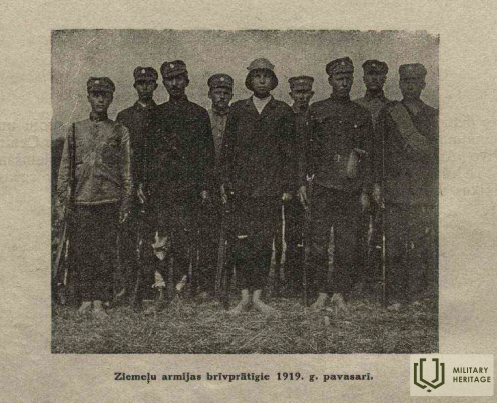
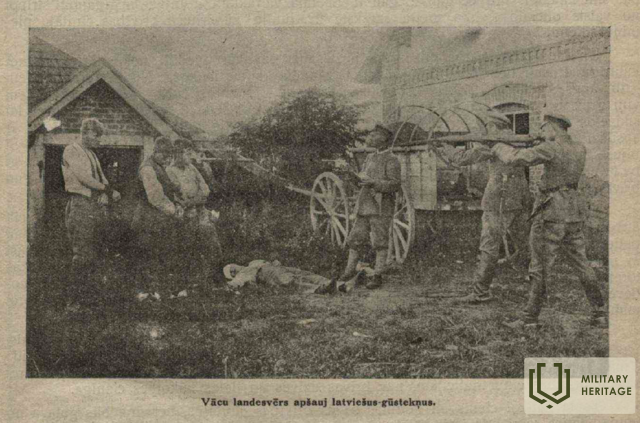
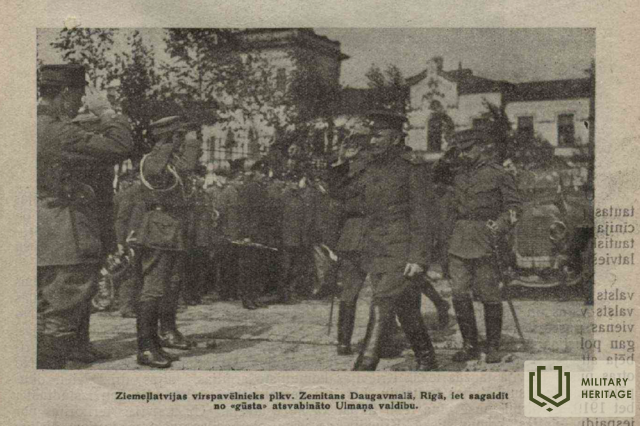


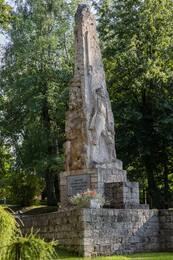
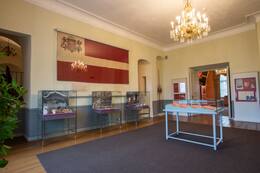
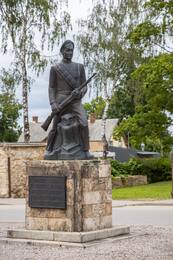
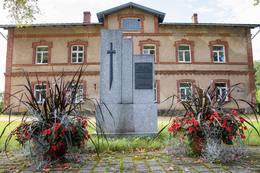
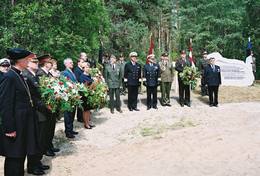
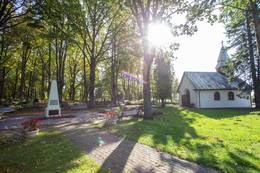
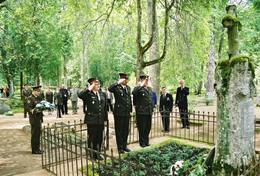
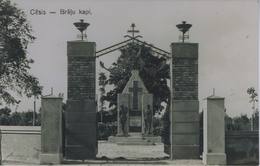
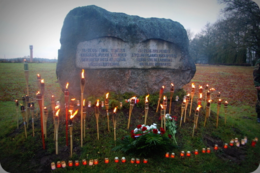
![Limbaži. President J. Čakste unveils a monument in Limbaži to those who fell in World War I. Unveiling of the Latvian Freedom Struggle Monument [1923]. Source: The National Library of Latvia's digital collection "Lost Latvia".](/g/Poi/00403/44213.png?size=260)
